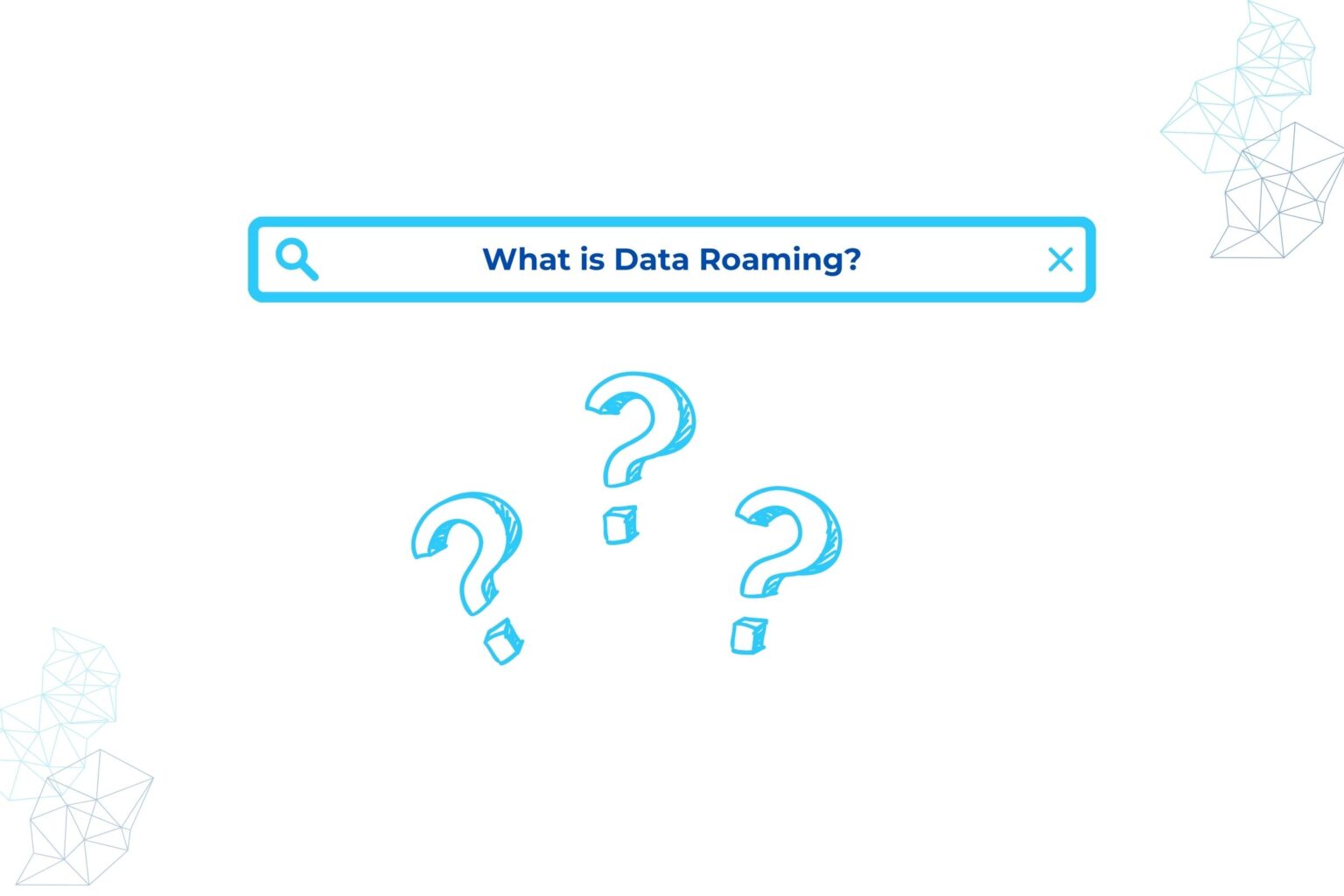Introduction
Staying online while traveling has become just as essential as carrying your passport. But what is data roaming, and why does it often come with expensive charges? In this complete guide, we’ll break down what data roaming means, how it works, and how you can stay connected abroad without draining your travel budget.
Whether you’re a backpacker exploring Southeast Asia, a digital nomad hopping between countries, or a business traveler who needs uninterrupted connectivity, understanding data roaming is the first step to avoiding costly surprises. We’ll also explore smarter, budget-friendly alternatives like local SIM cards and travel eSIMs, so you can enjoy seamless connectivity anywhere in the world.
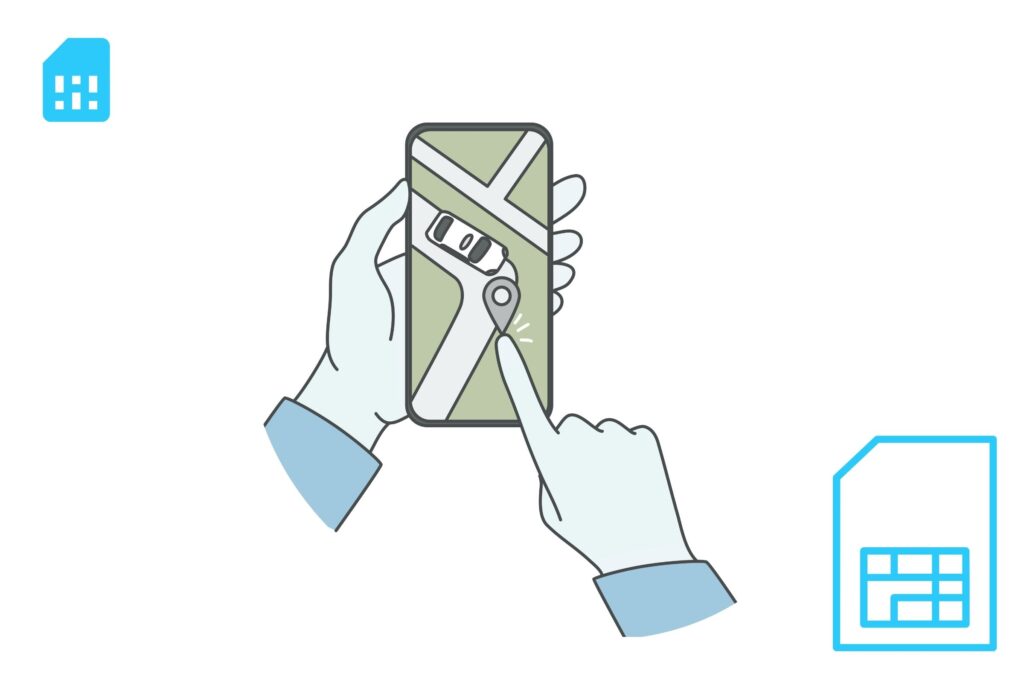
Traveler using smartphone with a map overlay
Hate surprise charges? Switch to a prepaid eSIM and skip the roaming traps—no contracts, no bill shock, just smooth internet abroad.
What is Data Roaming and How Does it Work?
Simply put, data roaming means using your mobile data when you’re outside your home network’s coverage area, typically while traveling abroad. Instead of disconnecting, your phone automatically connects to a foreign partner network so you can continue browsing the internet, checking emails, using maps, or staying active on social apps.
Here’s how international data roaming works step by step:
- Network Detection → When you leave your carrier’s coverage area, your phone scans for available local networks.
- Connection Setup → Your provider connects you to a partner network through existing roaming agreements.
- Data Transmission → You can now use mobile data as usual, but your home carrier tracks your usage and charges you accordingly.
While convenient, roaming can get expensive if you don’t understand how it works. That’s why knowing what data roaming means and how it functions is the first step to avoiding unexpected bills during your trip.
Pro Tip: If you want uninterrupted internet access abroad without the high roaming fees, consider using a travel eSIM for instant activation and better local rates.
The Cost of Convenience: Why Data Roaming Can Be Expensive
Using data roaming lets you stay connected anywhere, but this convenience often comes with a high price. Many travelers are surprised by international roaming fees when they receive their bills after a trip — sometimes adding up to hundreds of dollars.
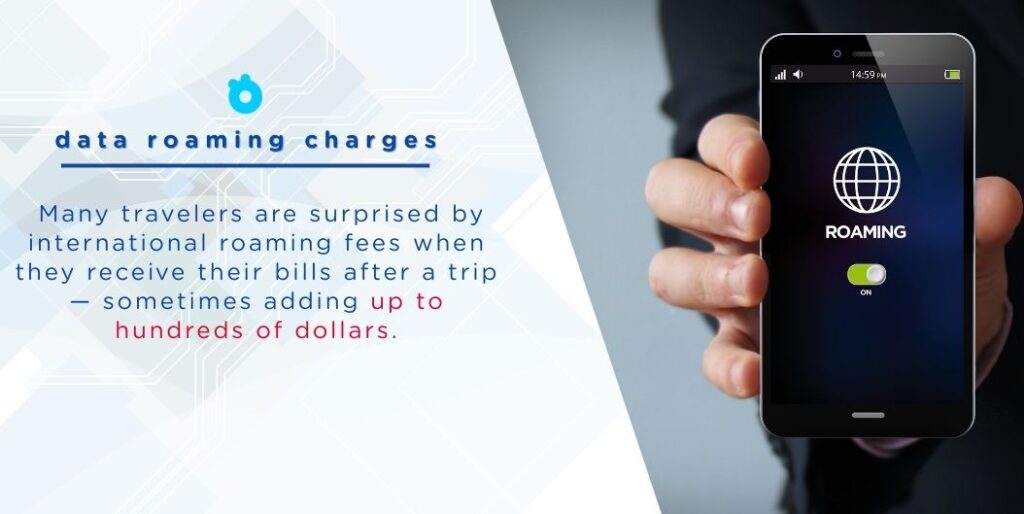
Here’s why data roaming charges can be so expensive:
- Inter-Carrier Agreements
When your phone connects to a foreign network, your home carrier pays that network for your data usage — and passes the cost directly to you. - Limited Competition in Some Regions
In countries with fewer carriers, there’s less price competition, which often results in higher roaming costs. - Pay-Per-Megabyte Pricing
Many providers still charge by the megabyte instead of offering flat-rate data packages.
For example, some U.S. carriers charge up to $2.05 per MB while roaming internationally. Streaming a single YouTube video could cost you $20 or more.
- Lack of Transparency
Roaming rates are often buried in fine print, making it difficult for travelers to estimate their costs beforehand.
Pro Tip: To avoid roaming charges, consider switching to a travel eSIM plan. With instant activation, affordable local rates, and multi-country coverage, eSIMs are becoming the smarter choice for international travelers.
Managing Data Roaming: Tips and Strategies
Staying connected abroad doesn’t have to mean paying sky-high roaming fees. By learning how to manage your data roaming settings effectively, you can avoid costly surprises and stay in control of your mobile data usage.
How to Turn Data Roaming On and Off
One of the simplest ways to manage data roaming is by controlling when it’s active. Here’s how to toggle data roaming on various devices:
For iPhone:
- Go to Settings > Cellular or Mobile Data
- Tap Cellular Data Options or Mobile Data Options
- Toggle Data Roaming on or off
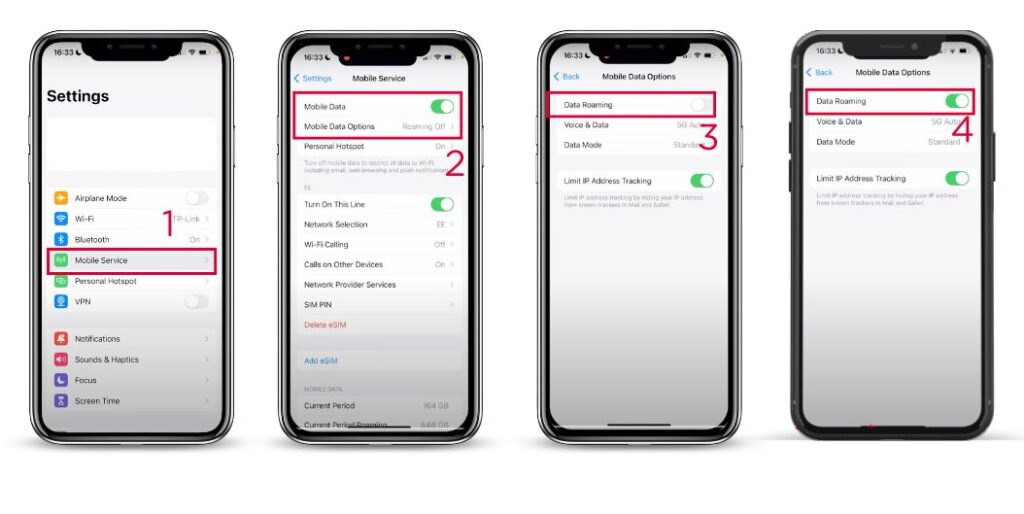
For Android:
- Go to Settings > Connections > Mobile Networks
- Toggle Data Roaming on or off
Remember, turning off data roaming doesn’t affect your ability to use Wi-Fi networks abroad.
Setting Data Limits and Alerts
To avoid bill shock, set up data usage alerts:
For iPhone:
- Go to Settings > Cellular > Cellular Data Usage
- Scroll down and tap “Reset Statistics” to start fresh
- Check this regularly to monitor your usage
For Android:
- Go to Settings > Connections > Data Usage
- Set a data warning and limit
By setting these alerts, you’ll receive notifications as you approach your data limit, helping you stay within budget.
Alternatives to Data Roaming
High data roaming charges don’t have to ruin your travel experience. Luckily, there are several data roaming alternatives that can help you stay connected abroad without paying premium fees.
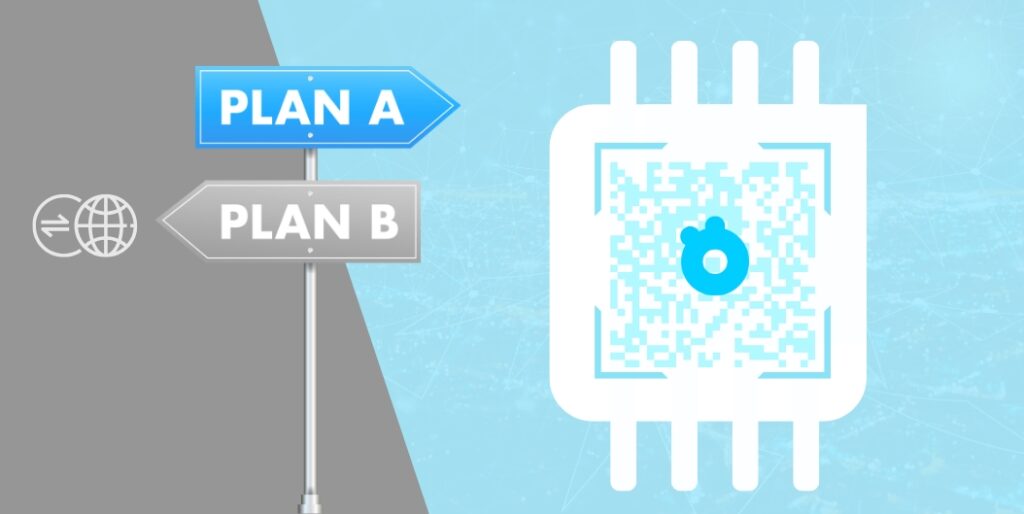
Local SIM Cards: The Budget-Friendly Option
Purchasing a local SIM card can be an excellent alternative to data roaming. Here’s why:
- Cost-Effective: Local rates are often much cheaper than roaming charges.
- Better Coverage: Local SIMs typically offer better network access within the country.
- Flexibility: Many providers offer short-term plans perfect for travelers.
However, remember that using a local SIM means you’ll have a new phone number, which can be inconvenient for receiving calls or texts from home.
eSIM Technology: The Future of Travel Connectivity
eSIMs (embedded SIMs) are revolutionizing how travelers stay connected. Here’s what makes them stand out:
- Convenience: No physical SIM card needed; activate plans digitally.
- Multiple Profiles: Keep your home number while using a local data plan.
- Wide Coverage: Many eSIM providers offer plans covering multiple countries.
Gohub’s eSIM solutions provide seamless connectivity across over 100 countries, making it an ideal choice for frequent travelers.
Wi-Fi Hotspots: Free but Limited
Relying on Wi-Fi hotspots can be a free way to stay connected:
- Pros: No data charges, widely available in urban areas.
- Cons: Limited availability, potential security risks, inconsistent speeds.
When using public Wi-Fi, always use a VPN to protect your personal information.
Quick Comparison Table
| Feature | Local SIM | Travel eSIM | Wi-Fi Hotspots |
|---|---|---|---|
| Activation | Buy & swap SIM | Instant QR activation | Manual connection |
| Coverage | Single country | Multi-country (100+) | Location-based only |
| Phone Number | New local number | Keep home number | N/A |
| Cost | Low local rates | Affordable local rates | Free |
| Convenience | Medium | High | Low |
By exploring these data roaming alternatives, you can choose the best way to avoid roaming charges based on your travel style and destination. For most modern travelers, a travel eSIM is the most flexible and cost-effective solution.
Smart Data Usage Habits for Travelers
Even if you rely on data roaming alternatives like eSIMs or local SIM cards, adopting smart data usage habits can further help you reduce data roaming usage and cut unnecessary costs. These data-saving tips while traveling make it easier to stay connected abroad efficiently.
Offline Maps and Content
Before your trip, download essential content:
- Use Google Maps’ offline feature to download city maps.
- Save important documents like boarding passes and hotel reservations.
- Download entertainment content like music, podcasts, or e-books.
These preparations can significantly reduce your need for data roaming.
Data-Saving App Settings
Optimize your apps to use less data:
- Disable auto-play videos on social media apps.
- Turn off background app refresh for non-essential apps.
- Use data compression features in browsers like Chrome.

Messaging Apps for Efficient Communication
Utilize messaging apps that use less data:
- WhatsApp and Facebook Messenger for texts and calls.
- Skype for international calls (uses less data than traditional voice calls).
These apps can help you stay in touch without incurring high roaming charges.
Understanding Roaming Agreements and International Plans
When traveling abroad, your home carrier has to rely on partner networks to keep you connected. These partnerships are managed through roaming agreements, and understanding how they work can help you choose smarter international data plans and avoid unexpected costs.
EU Roaming Regulations
For travelers within the European Union, roaming has become much more affordable:
- “Roam Like at Home”: EU citizens can use their domestic plans in other EU countries without additional charges.
- Fair Use Policy: Limitations may apply for extended stays abroad.
This policy has significantly reduced the cost of staying connected for EU travelers.
International Day Passes
Many carriers offer daily roaming passes:
- Flat Fee: Pay a set amount per day for a data allowance.
- Convenience: Use your regular number and plan abroad.
- Considerations: Can be expensive for longer trips.
For example, some U.S. carriers offer day passes ranging from $5 to $10 per day.
Pro Tip: With Gohub travel eSIMs, you can skip complicated roaming agreements and enjoy high-speed data in over 100+ countries at a fraction of the cost.
3. Roaming Packages and Travel Data Plans
Some carriers provide travel-specific roaming packages designed for short-term international use:
- Data Bundles → Buy a set amount of data to use abroad at a discounted rate.
- Multi-Country Packages → Ideal for trips covering several destinations.
- Travel Data Passes → Usually valid for a fixed period, like 7, 14, or 30 days.
However, these packages can still be costlier compared to local SIM cards or travel eSIMs.
4. Travel eSIMs: A Smarter Alternative
Instead of paying premium international roaming fees, modern travelers are switching to travel eSIMs:
- Affordable local data rates without unexpected charges.
- Instant activation via QR code.
- Multi-country coverage in a single plan.
- Keep your home number active while using local data.
| Option | Cost | Ease of Use | Coverage | Best For |
|---|---|---|---|---|
| EU Roam Like at Home | Included | Seamless | EU Countries | EU Residents |
| International Day Pass | $5–$10/day | Easy | Limited countries | Short trips |
| Roaming Packages | Moderate–High | Moderate | Single or multi-country | Occasional travelers |
| Travel eSIM | Low local rates | Instant | 100+ countries | Frequent travelers |
By understanding international roaming plans and exploring data roaming alternatives like travel eSIMs, you can choose the best way to stay connected abroad without overspending.
The Future of Mobile Connectivity for Travelers
The landscape of international mobile connectivity is evolving rapidly. As technology advances, travelers can expect faster speeds, wider coverage, and more affordable solutions. Here’s what’s coming next:
1. 5G Roaming: Faster Speeds, Smarter Plans
With the global rollout of 5G networks, expect a major shift in international roaming plans:
- Ultra-fast speeds make remote work, video calls, and streaming seamless.
- More competitive pricing as carriers expand their 5G roaming agreements.
- Wider availability in urban hubs and popular tourist destinations.
Pro Tip: When choosing a travel eSIM, look for providers like Gohub that already support 5G roaming plans for a faster, more reliable experience.
2. Satellite Internet: Global Connectivity Anywhere
Emerging solutions like satellite-based internet aim to solve connectivity gaps where traditional mobile networks struggle:
- Always-on coverage in remote regions, deserts, mountains, or open seas.
- Services like Starlink are leading the way for travelers in off-grid areas.
- As prices drop, satellite internet for travelers could become an affordable backup to eSIM or local networks.
3. The Rise of eSIM Technology
As more devices adopt eSIM compatibility, travelers are shifting away from traditional SIM cards entirely:
- Multi-country plans on one device → no swapping SIMs.
- Instant activation from anywhere → scan a QR code and connect.
- Eco-friendly solution → reducing plastic waste from physical SIM cards.
With eSIM adoption accelerating, managing data roaming will become simpler and cheaper in the coming years.
4. Smarter Travel Data Packages
Carriers and eSIM providers are creating flexible global plans tailored for modern travelers:
- Pay only for what you use with smart data bundles.
- Combine multi-country coverage with budget-friendly pricing.
- Real-time usage tracking via apps and dashboards to avoid unexpected charges.
By staying ahead of these trends — from 5G roaming plans to satellite internet for travelers — you can prepare for a future where seamless global connectivity is the norm. For now, switching to travel eSIMs remains the smartest way to avoid data roaming costs and enjoy fast, reliable mobile data anywhere in the world.
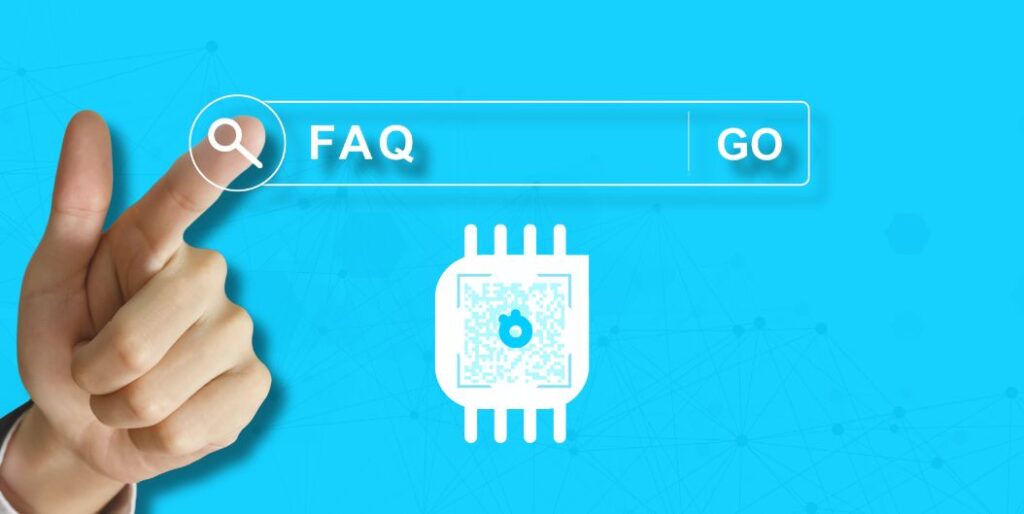
FAQs About Data Roaming
1. Should data roaming be on or off?
If you’re traveling internationally, keep data roaming off unless you have a roaming plan or travel eSIM to avoid unexpected charges. When you’re within your home country, you can leave it on without extra costs.
2. What happens if your data roaming is on?
When data roaming is on and you’re outside your carrier’s network, your phone connects to a foreign network. This allows you to browse, stream, and use apps, but it often comes with additional fees unless you’re using a local SIM or eSIM.
3. What is the purpose of data roaming?
The main purpose of data roaming is to keep you connected abroad when you’re outside your home network. It lets you use mobile data for internet access, messaging apps, maps, and emails even in another country.
4. Is data roaming free?
In most cases, data roaming isn’t free. Your carrier charges you based on international roaming agreements. However, you can avoid these fees by using local SIM cards or a travel eSIM with affordable data plans.
Conclusion: Staying Connected Without Breaking the Bank
Understanding what data roaming is and how to manage it is crucial for any traveler in today’s digital age. By employing strategies like using local SIM cards, leveraging eSIM technology, and adopting smart data usage habits, you can stay connected abroad without incurring astronomical fees.
Remember, the key to affordable connectivity lies in planning ahead and choosing the right solution for your travel needs. Whether you opt for Gohub’s flexible eSIM plans or decide to navigate the world of local SIMs, being informed about your options will ensure you stay connected without breaking your travel budget.
Before your next international adventure, take the time to review your connectivity options and set up the necessary safeguards. With the right approach, you can enjoy seamless global connectivity, sharing your travel experiences in real-time without worrying about a startling phone bill when you go back.
✈️ Stop paying double when you travel. Discover how travel eSIMs help you avoid roaming fees entirely and stay connected without stress.


